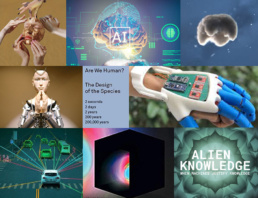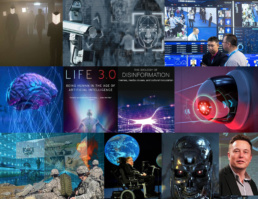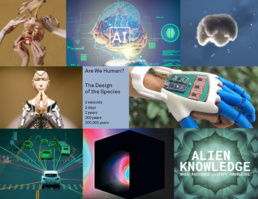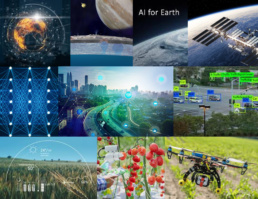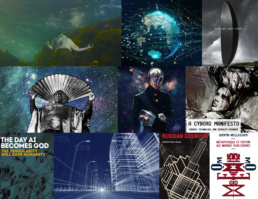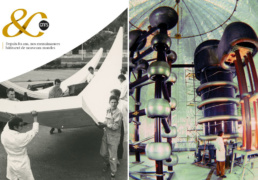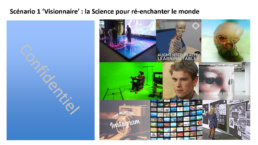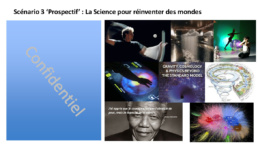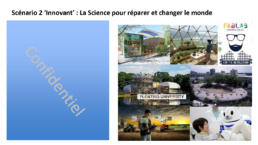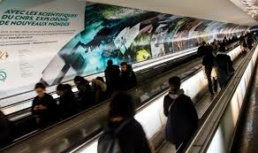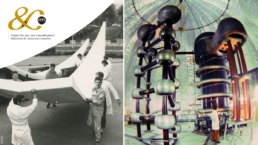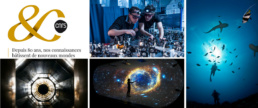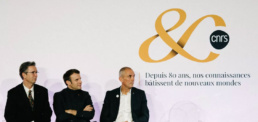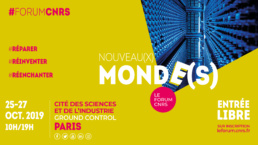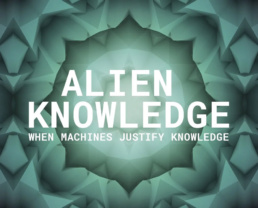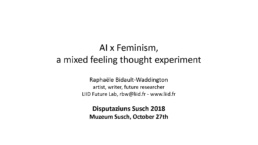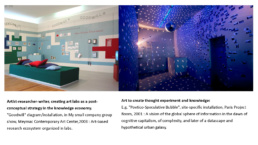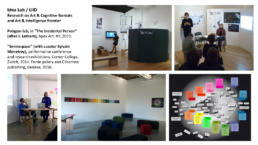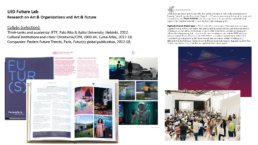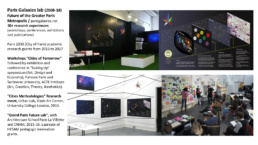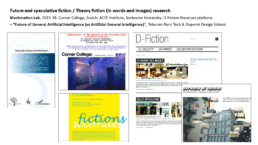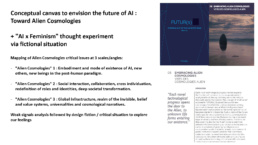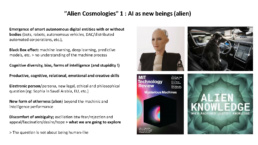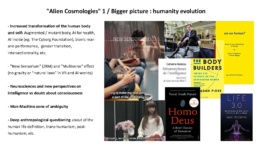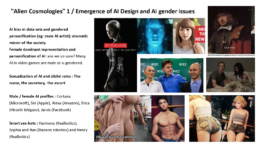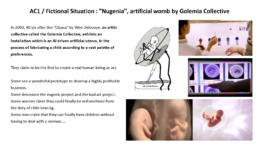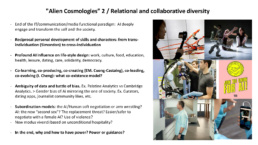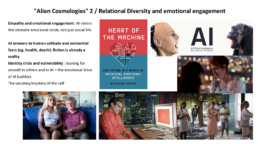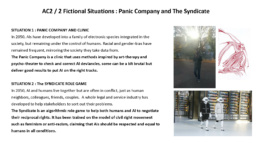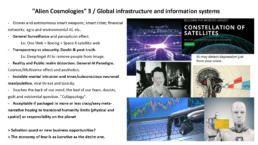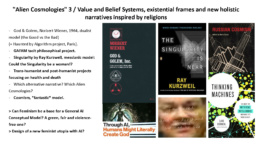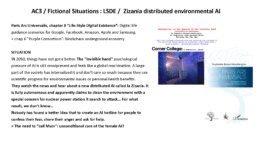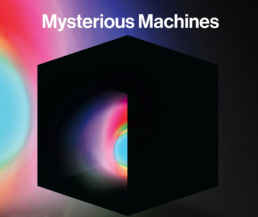TAC, AI and the Human Frontier, Muzeum Susch Magazine, 2020
Toward Alien Cosmologies,
AI and the Human Frontier
Essai et photomontages, Muzeum Susch Magazine MS#1, Suisse, 2020.
Faisant suite à la Disputaziune de 2018, cet essai revient sur les implications de l’IA et des technologies et combien elles font évoluer la condition humaine dans toutes ses dimensions. La peur qu’elles suscitent résonne avec celle provoquée par l’Anthropocène et les risques climatiques, et amplifie l’angoisse existentielle - énoncée par Heiddeger en ses temps - autant que le besoin de refonder de nouvelles visions du monde et de l’avenir.-
Des moodboards illustrent les parties du texte : Ecologie de la peur ; Nous sommes tous des aliens, nouveaux êtres et ontologies ; Négocier avec l’alien : vers un nouvel ordre relationnel, collaboratif et socio-économique ; Le féminisme comme filtre post-humain ; Distorsion spatiale, design d’écosystèmes étendus, et nouveaux panoramas conceptuels ; puis Science du futur.
Introduction
Since its launch in 2017, the Disputaziuns Susch conference series has adopted a multi-disciplinary approach to convening the most exciting and challenging thinkers – from scholars, artists and philosophers to authors, neuroscientists and historians – to engage in dynamic debates. Nestled in the shadow of the magnificent Alps, Muzeum Susch provides a peaceful haven in which ideas can be nurtured, deliberated and, ultimately, proposed as adaptable solutions rather than inflexible blueprints.
Having participated in the 2018 edition of Disputaziuns Susch, with her talk on ‘Artificial Intelligence and Feminism: A Mixed Feeling Thought Experiment’, Raphaële Bidault-Waddington’s latest essay references, in part, that year’s overarching theme ‘Do They Dream of Electric Sheep? Challenging Beliefs and Re-examining Assumptions about Artificial Intelligence’.
It is also informed by the central topic of Disputaziuns Susch 2019, ‘The Magicians of the Mountain’, which, paying homage to the celebrated encounter between philosophers Martin Heidegger and Ernst Cassirer in Davos in 1929, applies the question that led to their historical debate – ‘What is it to be human?’ – to alien cosmologies.
An Ecology of Fear
Martin Heidegger marked a turning point in the history of philosophy by including in his definition of existence mankind’s awareness of its finitude: the profound acknowledgement and anxiety of death. The emotional and bodily experience of fear became a keystone of Heidegger’s explorations of the human condition, in opposition to classic transcendental philosophy, which marginalized these feelings in the irrational (or animal) realms.
Today, with science demonstrating that emotions are biological processes which can be rationalized, instrumentalized or simulated by machines, fear still remains a core enzyme of the human condition and its ecosystems on all scales, from the individual to the societal to the global.
The most current threats – the anxiety and horror of environmental collapse (i.e. our awareness of earth’s tangible finitude) – are increasingly guiding the transformation of lifestyles and ethics. Young people around the world see the Anthropocene and the quest for environmental resilience as an urgent and powerful collective purpose.
Simultaneously, technology, AI and the broader digital transition are having an ambiguous anthropological impact on everything from the most intimate physical and psychological moments, to social interactions, to outer space and, ultimately, the hereafter. Impacting how we delineate the human condition, they are shaking up our cognitive belief systems and calling for new world visions.
Such bewildering disorientation, the vertigo of an expanded infinitude, provokes experiences that oscillate between fear and fascination. We need new cosmologies to apprehend and grapple with our presents and our futures.
We Are all Aliens, New Beings and Ontologies
Artificial Intelligence – i.e. algorithmic reasoning and machine learning – is not new, but the recent acceleration of calculation capacities and the sheer quantity of data available for training has allowed AI to be introduced in every facet of our existence on an unprecedented scale. This could be seen as just another advance in technology but, since AIs operate as black boxes, ‘mysterious machines’ [1] or alien knowledge, even their designers are not able to understand and justify their decision-making. This lack of explicability is at the heart of our fear and suspicion of AI – as though it is akin to a new form of magic.
Exactly what or who is AI? And what gives it the right to advise us, challenge us or take decisions for us? Accidents involving autonomous vehicles have already prompted the question, from a legal perspective, as to who is responsible: the company that manufactures the car or its designers, both of whom have been involved in setting up the hardware and software for decision-making.
Or is the vehicle an autonomous being acting on its own will? Conceptually, it is a fertile, rather than an extravagant, hypothesis to see AIs as a new family of algorithmic alien beings taking part in our social, mental and natural ecosystems, somewhere between the human (complex abstract reasoning capacity), the animal (non-human opaque behaviour) and machines (man-made and controlled artefacts). Designing future alien cosmologies means re-modelling the borders between these realms, at a time where they are challenged both physically and ontologically. In their eponymous 2016 publication, Beatriz Colomina and Mark Wigley ask: ‘Are We Human?’, proceeding to then detail how humanity has been continuously redesigning its own conditions throughout history. [2]
In physical terms, the frontier of biology and bio-engineering research shows that living cells can be fully designed, programmed and even 3D printed, denoting a new level of human mastery over life and living organs. The human body can be augmented with machinic and cyborg-like exo-skeletons to overcome disability [3] and even, as in the case of former Olympic sprinter Oscar Pistorius, to compete against and outperform non-augmented humans.
Medical science is similarly engaging with a new phase of evolution, concerning both reproduction and gender differentiation. What does ‘health’ mean under these new paradigms? When human senses can now be remodelled via different ‘mutant’ experiments, such as implants and biohacking, are we healing our bodies or improving them? Beyond this, digital technologies are even seeking to defy the physical limitation of death. These are not marginal experiments: technologies directly controlled by brain waves are already fully functioning and ready to be mass-marketed. As the Cyborg Foundation claims on its website: ‘We are the first generation able to decide what organs and senses we want to have.’ [4]
Exhibitions such as ‘New Sensorium’ at ZKM Karlsruhe in 2016 have highlighted artists’ engagement with the digital era’s transformation of human sensorial capacities and aesthetic codes, while Ian Cheng’s artificial life form project BOB (Bags of Belief) (2018–19) demonstrates how AI can assume many guises and can align with art to reflect mankind’s multitude of ambiguities, biases and distortions.
The distinction between human brain and machine mind is also becoming increasingly porous, with the one acting as a dynamic mirror to the other. While algorithms, in all their cognitive diversity, are showing affinities to (and differences from) human intelligence – sometimes mimicking it, sometimes overperforming it – we are still not entirely certain how the human mind functions.
Neuroscience and philosophy have remained separate fields for too long: now, they are in the process of resetting their disciplines to explore new convergences and confront the algorithmic evolution in different ways. In their recent publications, Yuval-Noah Harari [5] and Catherine Malabou [6] have argued that even the recognized human attribute of consciousness is becoming less concrete, demonstrating how the mind has its own ‘automatism’ that comes into play when making supposedly conscious decisions.
Is the human brain just as filtered by opaque biases as AI? Where do intelligence, truth and wisdom fit into all this? Human ethical and philosophical frameworks are being profoundly challenged by these new developments, consolidating the need for innovative, alien cosmologies.
Dealing with the Alien: a Relational, Collaborative and Socio-Economic New Order
Now omnipresent, computers and smartphones already dictate many of our life decisions, whether private, social or professional. Via our interactions with them, these machines participate in what Gilbert Simondon [7] calls the trans-individuation process – i.e. the construction of ourselves, both individually and collectively, as well as the design of societal networks and communities.
In recent decades, digital humanities have been highlighting these mechanisms and social transformations; with the introduction of AI, such relational patterns have led to the development of a new sociopsychology, beyond the interactive and the functional. Like personal assistants, machines have become increasingly tailored to our needs, mimicking us as individuals, and generating ever-more sophisticated, empathic, emotional and cognitive mechanisms and exchanges. A new society is emerging in which machines are stakeholders and anthropological definitions continue to evolve.
In work environments, the fear of seeing AI replace human labour is real and has been heightened by the general fragmentation and dissolution of workloads via the micro-tasking [8] economy and the shift from large corporations to informal organizations and peer-to-peer communities [9]. Yet, closer analysis reveals that AIs and machine learning – whether in the form of robots or bot interfaces – cannot deliver results without being trained and cared for by humans. This, again, mirrors how humans themselves develop skills. At a time when the knowledge economy is transforming in all fields – from academia and industry to the arts and third sector – this educational revolution, in which AI will play a pivotal role, is a subject of ongoing debate.
Ultimately, however, bias and value systems, as much as efficiency and responsibility, are at stake in this total reset of education, culture, economics and productivity.
The new alien cosmologies will involve these pioneering forms of training reciprocity and collaborative engagement (unlike the late-20th-century modes of communication that adhered to the information paradigm) and will call for fair-play guidelines that serve social justice. The relationship between humans and machines creates various interdependencies ranging from valuable support to subordination and even alienation.
Sentiments are provoked by these psycho-tech entanglements, especially when AIs coach or give advice. By providing feedback based on users’ mindscapes, AIs influence our quest for identity as much as they guide our decision-making – flattering our narcissism, fulfilling our demands for love and soothing our insecurities.
‘You look so good today,’ says your ideal augmented deep-fake persona and new friend. ‘You will never be alone.’ The pre-existing gamut of psychological games, rewarding mechanisms and social-structing [10] patterns can so easily be implemented with AI that users must remain ever-vigilant to the neural machinations in progress. The invisible workings of the market are also getting smarter and, as we know, employing all sorts of tricks to manipulate us into believing their promises.
Feminism as a Post-Human Filter
Unsurprisingly, feminine, sexualized AIs – caricatures of female instrumentalization – have proved successful in making AIs acceptable. They are kind and charming (the good girl), attentive (the good friend), entertaining and exciting (the escort, the prostitute) but no smarter than men: docile (the secretary), servile (the maid) and caring (the nurse).
By investing AIs with characteristics stereotypically perceived as female, fears around loss of control are abated while reciprocal empathy with the smart machine is prompted, at a time when for some, relationships between humans are increasingly volatile and disappointing. Sadly, this recalls (but also offers a new perspective on) the historical subordination of women by men.
Fear has been pivotal to the construction of that humanity-long history and anthropological bedrock. Finding solutions for the now-acknowledged risk of AIs’ gender or racial bias will certainly help to deconstruct this thread, rendering more transparent implicitly distorted value systems in men’s habits, such as those in recruitment, editorial or curating.
As part of the current anthropological turn toward alien cosmologies, AIs, with their presumably arbitration skills and ethical challenges, contribute to the redefinition of power, subordination and organizational models. Feminism offers a relevant conceptual matrix from which to draw new, impartial, inter-species relations, collaborations, organizations and justice.
Space Distortions, Expanded Ecosystem Designs and New Conceptual Panoramas
Beyond the ontological and relational, the AI paradigm not only conjures new constellations, values and representational systems, which influence our minds as much as AIs, but also new ambient technology ecosystems, fully entangled with socio-political and natural ecosystems.
Whether we speak of block-chain decentralized networks, of 5G technologies that increasingly connect, augment and accelerate, or of the cloud now populated with billions of smart bots and algorithmic entities, the digital realm is limitless. Its sprawling sensors, data and AIs not only serve ethically dubious purposes – political surveillance, social-credit checks, facial recognition, information distortion, military strategy, etc. – but are intrinsic to essential services such as health care and climatology and, consequently, will only continue to expand. Prompting radical criticism [11], the Anthropocene is fast becoming the byword for a new era of manmade geo-engineering that has ushered in global power and economic games.
In the midst of all this, the pertinent question we should really be asking is: what environmental governance could we design to reach a Green New Deal [12]? American communications giant OneWeb is building a network of satellites across Earth to enable permanent connectivity and so does China with the Hongyan constellation. Autonomous AIs will soon lead space-exploration vehicles [13], in a bid to expand human life into outer space, raising further anthropological concerns [14]. Both physically and conceptually, the AI era is of cosmological order, and thus cosmological theories can be of help in better grasping or representing the ubiquitous, multi-dimensional and distorted world being created.
Politically, alien cosmologies would need to include natural and intelligent entities – at the intersection of the cosmopolitical ‘Parliament of Things’, proposed by Bruno Latour in We Have Never Been Modern (1991), and Antoinette Rouvroy’s research into algorithmic democracy [15].
Spatially, we need to devise ‘cosmo-geographic’ maps in order to visualize the entanglement of virtual and real ecosystems, as well as to shed light on the invisible constellations of the digital AI era. Such efforts could help forge cognitive common ground with the black boxes of AIs, since their algorithmic ‘mind’ does not have a sense of space or gravity.
Future Science
Knowledge, truth and value systems are everywhere at stake in these post-human and post-truth alien cosmologies. The current ‘biology of disinformation’ [16] – unmoderated propaganda and viral media manipulation effective on a global scale – is not based on clear logic and intersects with the indistinct zone of our emotions, reptilian imagination and unconscious belief mechanisms.
The new ecology and economy of fear (and, with it, our hopes – demands – for salvation) are re-orienting, challenging or rendering obsolete the libidinal economy of desire. Both nestle in the part of our brain beneath rationale and ethics, adjacent to our innate comfort zone. Tapping into these existential human uncertainties – particularly in tandem with AI’s ‘magical’ power – is both alarming yet mesmerizing. Mimicking religious messianic or esoteric narratives, Ray Kurzweil’s The Singularity Is Near (2005) – which predicts such an exponential increase in technology that machine intelligence will far outstrip human intelligence – also plays on our innate risk-averse vulnerability.
In response, more holistic concepts, such as the pluriversity (the post-decolonization alternative to the universal dissemination of a Eurocentric model) or cosmo-technics (the conceptualization of a renewed relation between nature and technology, developed by Chinese philosopher Yuk Hui [17]) are proposing new technological futures, prompting discerning and emancipatory thinking.
What is missing in the current intellectual landscape – which has only recently become a concern in anthropological studies [18] but will be pivotal to designing alien cosmologies – is humanity’s dynamic and creative relationship to the future. Every facet of human existence is informed and influenced by this subjective and approximate computation. Occurring at the intersection of the real, the rational and the fictional, it provokes as much as fear as it inspires desire, agency and belief. To the opposite of science that is not meant to tell or demonstrate the future, predictive AIs are already massively influencing human future speculations.
The arts also play their part, having always served as lens through which to apprehend the future imaginings of its time. And more esoteric sciences start making sense at this frontier of the known and of the rational. Hydro-feminism (Neimas) emphasises the continuity of water and information between the inside and the outside of humans and relevantly defies the continuity/discontinuity anthropological matrix designed by Descola. Afro-futurism, which sees human as aliens, gives space to the invisible and reactivates a creative and projective relation to the cosmos to envision social justice, is also a valid inspiration.
The cosmos is a historical reflector of mankind’s comprehension of its future, acting as a screen onto which we project more or less idealized scenarios: from a house of god(s) that rules the world to a thrilling alien, non-gravitational playground to a potential means of survival and battle field.
What peaceful and resilient alien cosmologies can we design on that horizon to emancipate ourselves from these overly simplistic, fear-driven caricatures and futures? This is the first step we must take to address the Anthropocene and AI era, to reboot our mindset and lifestyles at the edge of the human condition, of science and of the future.
Notes
1 – Title of cover story about AI, MIT Technology Review, May/June 2017
2 – B. Colomina and M. Wigley, Are We Human? Notes on an Archaeology of Design, Lars Müller Publishers, 2016
3 – See cases of formerly disabled, ‘bionic’ men such as rock climber Hugh Herr or body builder Edgard John-Augustin
4 – Quote from www.cyborgfoundation.com
5 – Y.N. Harari, Homo Deus: a Brief History of Tomorrow, Harvill Secker, 2016
6 – C. Malabou, Métamorphoses de l’intelligence, Presses Universitaires de France, 2017
7 – G. Simondon, L’individuation psychique et collective, Paris, Aubier, 1989
8 – See the TaskRabbit.com platform developed by Amazon
9 – The music and media industries were among the first affected by job losses, due to the rise of informal content production on streaming platforms such as YouTube; apps like uber have extended this process while white collar and cognitive services are now becoming affected.
10 – See Marina Gorbis, The Nature of the Future: Dispatches from the Socialstructed World, 2013
11 – See: T.J. Demos ‘To Save a World: Geo-engineering, Conflictual Futurisms and the Unthinkable’, e-flux journal #94, 2018
12 – J. Rifkin, The Green New Deal: Why the Fossil Fuel Civilization Will Collapse by 2028, and the Bold Economic Plan to Save Life on Earth, St Martin Press, 2019
13 – In 2018, for instance, Nasa placed the robot CIMON aboard the International Space Station.
14 – See: ‘Toward an Anthropology of Space; Orientating Cosmological Futures’, a conference at the Institute of Advanced Studies, University College London, 2017
15 – ‘The end(s) of critique: data-behaviourism vs. due-process’, in Hildebrandt, M. and De Vries, E. (eds.) Privacy, Due process and the Computational Turn: Philosophers of Law Meet Philosophers of Technology, Routledge, 2012
16 – See: J. Dunagan, D. Pescovitz and D. Rushkoff, ‘The Biology of Disinformation’ report, Institute for the Future, Palo Alto, 2018
17 – Y. Hui, ‘Cosmotechnics as Cosmopolitics’, e-flux journal #86, 2017
18 – Among many recent publications showing the rising concern for the future in the anthropology community see: S. Pink and J.F. Salazar, Anthropologies and Futures: Researching Emerging and Uncertain Worlds, Bloomsbury, 2017
Raphaële Bidault-Waddington
Rappel des axes de recherche du lab
Axe 1 : Transitions et Mondes Futurs
Axe 2 : Innovation Méthodologie Prospective
Axe 3 : Art et Recherche Prospective
Articles associés à celui-ci
Rien trouvé.
Nos Connaissances bâtissent de Nouveaux Mondes, 80 ans du CNRS, Paris, 2018-19
Nos Connaissances bâtissent de Nouveaux Mondes
Réflexions prospectives et co-design d'un programme pour les 80 ans du CNRS
Direction de la Communication du Centre National de la Recherche Scientifique, Paris, 2018-19.
Ce futur lab consiste à mettre en place une cellule de réflexion prospective avec toute l’équipe de la communication (20 personnes), afin de soutenir le design d’un ambitieux programme d’événements locaux, nationaux et internationaux pour les 80 ans du CNRS, autour du thème ‘Nos connaissances bâtissent de nouveaux mondes’.-
Il est l’occasion d’utiliser et d’enrichir nos recherches prospectives sur le changement de monde en cours, d’ébaucher des premières cartographies des enjeux multi-scalaires des grandes transitions - qui impulsera ensuite la conception du TAC Future Canvas -, d’ouvrir de nouvelles questions et perspectives d’avenir sur le futur de la connaissance dans toutes ses dimensions.

Présentation du lab
Le CNRS (Centre National de la Recherche Scientifique) est le deuxième plus gros institut de recherche scientifique au monde avec plus de 1100 laboratoires dans tous les domaines de la connaissance, et 28 000 chercheurs en France et à l’étranger.
A l’occasion de ses 80 ans la Direction de la Communication souhaite repositionner l’institut à l’avant-garde de la recherche scientifique internationale, en proposant un ambitieux programme d’événements à Paris et en région. Ces événements, structurés autour du grand thème de « Nos connaissances bâtissent de nouveaux mondes », sont destinés aussi bien à la communauté scientifique française, européenne et internationale, qu’au grand public, ou encore aux écosystèmes d’innovation.
Afin d’accompagner la conception et la curation de ce vaste programme, nous mettons en place une démarche d’inspiration prospective (futur lab) pour nourrir les équipes de la Direction de la Communication (20 personnes), co-concevoir et positionner cet agenda dans les transitions et tendances les plus actuelles.
Le lab comprend :
– Une série d’entretiens internes pour clarifier les enjeux stratégiques du CNRS,
– L’apport d’éclairages prospectifs sur les grandes transitions en cours et leurs implications, que ce soit pour la science, la société, ou le monde ;
– Des séances travail en petit groupe ou en atelier ;
– L’apport d’idées et le pré-design de « scénarios d’inspiration prospective » pour faciliter aussi bien la pluralité que la convergence ;
– Des recommandations de lieux, de partenaires ou de formats d’événements de nouvelle génération.
Dans le respect de nos engagements contractuels de confidentialité, nous ne communiquons pas les contenus produits et idées développées.
quelques slides extraites de la recherche amont et utilisées dans le kit d'atelier
quelques images des très nombreux éléments du programme d'événements
Rappel des axes de recherche du lab
Axe 1 : Transitions et Mondes Futurs
Axe 2 : Innovation Méthodologie Prospective
Axe 3 : Art et Recherche Prospective
Articles associés à celui-ci
Rien trouvé.
Do They Dream of Electric Sheep?, Muzeum Susch, Suisse, 2018
AI x Feminism
a mixed feeling thought experiment
Disputaziune #2 « Do They Dream of Electronic Sheeps » (Curator: Mareike Dittmer), Muzeum Susch, Suisse, 2018.
Cette keynote est l’occasion de reformuler de manière très synthétique les enjeux multi-scalaires de l’IA depuis leur ambiguïté ontologique jusqu’au défis planétaires, puis d’adresser plus spécifiquement la question du genre, en s’appuyant sur de nombreux ‘signes du futur’ ainsi que sur les expériences fictionnelles du lab réalisé cette même année.-
Biais genrés des algorithmes et du machine learning accentuant les inégalités et les clichés, féminisation archétypale des interfaces de l’IA favorisant leur acceptabilité, sexbots augmenté d’IA, reproduction humaine optimisée ou remplacée par l’IA, IA ersatz de la relation amoureuse ou du besoin d’amour universel…
-
Les enjeux de l’IA qui se jouent en miroir de ceux de l’humanité, permettent de revisiter sous un nouvel angle toutes les problématiques du genre, et de mobiliser les philosophies féministes à l’endroit des technologies et notamment de leur subordination.
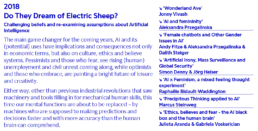
Following a series of recent researches about the future of AI and its specific ecology of affects, I would like to create and share a new thought experiment, to highlight critical issues, address ambiguities and play with paradoxes at the cross-road of AI and Feminism. The discursive perambulation will set and navigate a broad almost vertiginous, cognitive panorama, mirroring the one of AI.
RBW
Slides de l'intervention
A propos de Dispataziune Susch #2 "Do They Dream of Electric Sheep"?
Challenging beliefs and re-examining assumptions about Artificial Intelligence
The main game changer for the coming years, AI and its (potential) uses have implications and consequences not only in economic terms, but also on culture, ethics and believe systems. Pessimists and those who fear, see rising (human) unemployment and civil unrest coming along, while optimists and those who embrace, are painting a bright future of leisure and creativity.
Either way, other than previous industrial revolutions that saw machinery and tools filling in for mechanical human skills, this time our mental functions are about to be replaced – by machines who are supposed to making predictions and decisions faster and with more accuracy than the human brain can comprehend.
The scale of this challenge has not fully arrived with government agencies, business leaders and scientists, and it seems essential to think about frameworks and regulations that would accompany this change before it settles without other leading forces than the profit-making of the tech industries. Algorithmic deficiencies based on the biases of the programmers need to be identified and a code of conduct as well as greater diversity among the engineers and computer scientists developing AI could go a long way toward minimizing these biases.
To quote Marina Gorbis, executive director of the Institute for the Future: “We need technologists who understand history, who understand economics, who are in conversations with philosophers, we need to have this conversation because our technologists are no longer just developing apps, they’re developing political and economic systems.” These are very present issues that need to be urgently addressed, since the technologies become more prevalent.
Thus, we want to bring diverse speakers from science, art, academia, tech and economy together to analyse the factual status of AI, its impact and its possible futures, and to discuss agencies broaching the mysticism of both technological and artificial power structures, the changing narratives in the human machine discourse and the transfer of gender imbalances from the physical to digital worlds:
Can empathy be programmed and what is it to be human? Does it matter that AI is 95% coded by men? Do we replace the Deus ex Machina with machines with godlike attributes? What holds believes?
By taking facts to arguments and charging them with tension we will intensify the energy thinking holds and playfully expand realities.
Rappel des axes de recherche du lab
Axe 1 : Transitions et Mondes Futurs
Axe 2 : Innovation Méthodologie Prospective
Axe 3 : Art et Recherche Prospective
Articles associés à celui-ci
Rien trouvé.
Futur de l’Intelligence Artificielle Générale, Forccast, Telecom ParisTech, 2018
Futur de l’Intelligence Artificielle Générale
Expérience de recherche prospective par la fiction
Commande du programme FORCCAST, Telecom Paris Tech, Paris, 2018.
Cette expérience de recherche menée avec une équipe de chercheurs de Telecom Paris Tech - dans le cadre de sa contribution au programme interdisciplinaire Forccast - a consisté à développer une série de fictions spéculatives situées en 2050 et révélant différents enjeux critiques du paradigme de l’Intelligence Artificielle Générale.-
Le protocole narratif spécifique et structuré en une série de courts récits enchâssés, permet d’aborder ces enjeux à différentes échelles, suivant notre principe de recherche ‘polygonale’. Ces récits intègrent des personnages mais aussi des organisations réelles et fictives, ouvrant des perspectives plus systémiques, stratégiques ou politiques. Une recherche picturale vient compléter les récits.
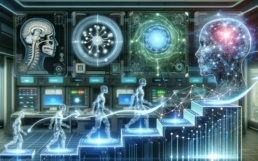
Collaboration avec Telecom Paristech et le programme Forccast
Suite à ses recherches dans le cahier Futur(s) et à la sortie de son livre « Paris Ars Universalis, scénario-fiction d’un futur Grand Paris » en 2017, Raphële Bidault-Waddington est mandatée par une équipe de Telecom Paris Tech pour développer une recherche par la fiction sur le futur de l’IA.
Cette expérimentation s’inscrit dans ses engagements pour (et est financé par) le programme transdisciplinaire FORCCAST impulsé par Bruno Latour et porté par un consortium d’écoles et d’universités (Science-Po, Mines Telecom Paris Tech, etc.).
Au sein de Forccast, les partenaires expérimentent différents formats de production et de transmission de connaissances. Du côté de Télécom Paristech, l’équipe conjugue deux dimensions fondamentales du programme : l’analyse des controverses et l’incarnation des acteurs par la simulation ou la fictionnalisation.
Reconceptualiser les enjeux de l’Intelligence Artificielle Générale
Cette collaboration donne lieu à la conception d’une dizaine de situations spéculatives toutes situées en 2050, où l’IA Générale dans toute sa diversité est utilisée et mise en récit pour en dérouler les implications (et les bugs) futures.
Le paradigme de l’IAG, l’Intelligence Artificielle Générale, est ici radicalement reconceptualisé comme celui d’un monde où les IAs se déclinent en de très nombreuses formes et modalités, et viennent trouver leur place dans toutes les dimensions de la société et de la réalité.
A l’inverse du concept habituel d’IA Générale, qui verrait celle-ci comme une forme d’intelligence générique, agnostique, et applicable à toute chose (simulacre d’une intelligence humaine soi-disant universelle), l’IA est ici envisagée dans sa plus grande diversité cognitive, relationnelle et de facto culturelle.
A noter que ce travail de reconceptualisation est essentiel dans la recherche prospective.
Protocole et architecture narrative innovante
Comme RBW l’avait fait dans Paris Ars Universalis, les récits incluent de nombreuses organisations autant réelles que fictives et dotées de stratégies, ceci permettant d’interroger les enjeux de l’IA à des échelles plus systémiques, et non simplement celle de l’expérience humaine (UX) habituellement retenue dans les pratiques de Design Fiction. Ce parti-pris multi-scalaire deviendra un élément clé de toute l’innovation méthodologique du TAC Future Lab et de la conception du TAC Future Canvas.
Le protocole narratif qui utilise un principe de récit enchâssé – chaque sous-histoire est une expérience d’un laboratoire fictif nommé Open Polygon, dont les protagonistes s’expriment et qui a sa propre histoire – permet de réaborder de manière plus critique et théorique chaque situation, et d’ouvrir ainsi encore d’autres perspectives (principe de recherche multi-facette dite ‘polygonale’).
Chaque récit est ainsi précédé d’un ensemble d’hypothèses spéculatives concernant le monde en 2050 et posées en préambule de l’histoire.
Enfin, une recherche d’images, dont certaines sont des créations de RBW, permet de donner à sentir encore autrement les situations et expériences spéculatives du futur de l’IA Générale.
Conçu comme un module d’expérimentation interne à l’équipe de recherche, ces travaux très riches et toujours très actuels n’ont malheureusement pas été publiés faute de budget disponible. Cette matière est cependant remobilisée dans d’autres expérience du TAC Future Lab.
Le Consortium Godel & Glitch (CGG) imaginé dans l’une des histoires est par exemple repris dans une expérience de Design Fiction menée avec les étudiants de l’Ecole Duperré à Paris.
In fine, cette expérimentation méthodologique et narrative, y compris ses écueils telles que sa non-publicisation, vient enrichir les démarches d’innovation méthodologique du TAC Future Lab.
Rappel des axes de recherche du lab
Axe 1 : Transitions et Mondes Futurs
Axe 2 : Innovation Méthodologie Prospective
Axe 3 : Art et Recherche Prospective
Articles associés à celui-ci
Rien trouvé.
